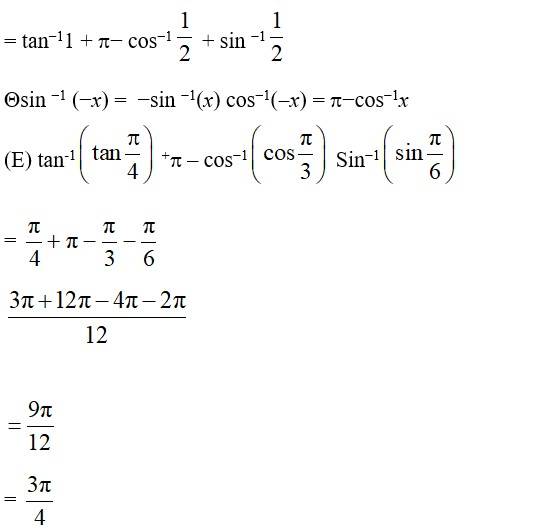Ncert Solutions Maths class 12th
Get insights from 2.5k questions on Ncert Solutions Maths class 12th, answered by students, alumni, and experts. You may also ask and answer any question you like about Ncert Solutions Maths class 12th
Follow Ask QuestionQuestions
Discussions
Active Users
Followers
New answer posted
5 months agoContributor-Level 10
Let cos -1 =y Then cos y = = − cos
cos
= cos
= cos
(E) We know that the range of principal value
branch of cos−1 is [0, ] and cos =
Principal value of cos−1 is
New answer posted
5 months agoContributor-Level 10
Let sin−1 =y. Then, sin y=-
We know that the range of principal value branch of sin−1 is
and sin−1
=
Principal value of sin−1
New answer posted
5 months agoContributor-Level 10
A binary operation * on {a, b} is a function from {a, b} * {a, b} → {a, b}
i.e., * is a function from { (a, a), (a, b), (b, a), (b, b)} → {a, b}.
Hence, the total number of binary operations on the set {a, b} is 24 i.e., 16.
The correct answer is B.
New answer posted
5 months agoContributor-Level 10
It is given that,
Also,
Now, let
Then, we have:
Thus, when
Hence, fog and gof do not coincide in (0, 1).
Therefore, option (B) is correct.
New answer posted
5 months agoContributor-Level 10
It is clear that 1 is reflexive and symmetric but not transitive.
Therefore, option (A) is correct.
New answer posted
5 months agoContributor-Level 10
It is given that A = {–1, 0, 1, 2}, B = {–4, –2, 0, 2}
Also, it is given that
It is observed that:
Hence, the functions f and g are equal.
New answer posted
5 months agoContributor-Level 10
Let X={0, 1, 2, 3, 4, 5}.
The operation* on X is defined as:
An element
For
Thus, 0 is the identity element for the given operation*.
An element
i.e.,
But, X={0, 1, 2, 3, 4, 5} and
Hence, the inverse of an element
* | 0 | 1 | 2 | 3 | 4 | 5 |
0 | 0 | 1 | 2 | 3 | 4 | 5 |
1 | 1 | 2 | 3 | 4 | 5 | 0 |
2 | 2 | 3 | 4 | 5 | 0 | 1 |
3 | 3 | 4 | 5 | 0 | 1 | 2 |
4 | 4 | 5 | 0 | 1 | 2 | 3 |
5 | 5 | 0 | 1 | 2 | 3 | 4 |
New answer posted
5 months agoContributor-Level 10
It is given that ∗: P (X) * P (X) → P (X) be defined as
A * B = (A – B) ∪ (B – A), A, B ∈ P (X).
Now, let A? P (X). Then, we get,
A *? = (A –? ) ∪ (? –A) = A∪? = A
? * A = (? - A) ∪ (A -? ) =? ∪A = A
A *? = A =? * A, A? P (X)
Therefore? is the identity element for the given operation *.
Now, an element A? P (X) will be invertible if there exists B? P (X) such that
A * B =? = B * A. (as? is an identity element.)
Now, we can see that A * A = (A –A) ∪ (A – A) =? ∪? =? A? P (X).
Therefore, all the element A of P (X) are invertible with A-1 = A.
Taking an Exam? Selecting a College?
Get authentic answers from experts, students and alumni that you won't find anywhere else
Sign Up on ShikshaOn Shiksha, get access to
- 65k Colleges
- 1.2k Exams
- 687k Reviews
- 1800k Answers

